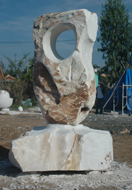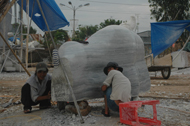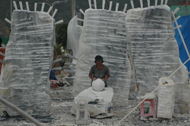- Details
-
Created: Wednesday, 01 November 2006 21:58
Working Environment
The carving area is an open field. They have run underground conduit and brought up little service panels every 50 feet or so. From these panels they run 2 or  3 cables with a double outlet. The workhorse grinders we use are 9 inch Bosch electric with 8 inch blades. For some reason they cut the plugs off the grinders, strip an inch of the insulation off the wire, and twist both copper wires into tight spikes. Then you just poke the wire spikes into the outlet. Some of the workers wear ear protection, especially if you insist. Some of them wear dusk masks, especially if you insist. None of them wear eye protection. They avoid getting wet from carving, which I found surprising at first. Wet keeps you cool. But then I realized they probably don’t have 4 different carving outfits as I do. They cannot afford to pay the $.75 per day for laundry. And living 10 to a room they may not have room to easily do their laundry, so they just try to stay clean.
3 cables with a double outlet. The workhorse grinders we use are 9 inch Bosch electric with 8 inch blades. For some reason they cut the plugs off the grinders, strip an inch of the insulation off the wire, and twist both copper wires into tight spikes. Then you just poke the wire spikes into the outlet. Some of the workers wear ear protection, especially if you insist. Some of them wear dusk masks, especially if you insist. None of them wear eye protection. They avoid getting wet from carving, which I found surprising at first. Wet keeps you cool. But then I realized they probably don’t have 4 different carving outfits as I do. They cannot afford to pay the $.75 per day for laundry. And living 10 to a room they may not have room to easily do their laundry, so they just try to stay clean.
For extended hours carving they have lots of lights on normal overhead street light fixtures as well as bulbs on a stick (fluorescent fixtures mounted on sticks that they can poke in the sand near the work). I found the bugs are overwhelming near lights after dark, so have not even considered coming back after dinner. A massive crane runs around the site turning over sculptures, moving sculptures and bases, taking away large waste rocks. A dump truck carries the stones from place to place, after the crane places the stone in the truck. There is an 8-man crew of stone chip picker-uppers. Once a stone goes into the waste pile we are not allowed to use it, even if it is perfect for a base or small piece. The crane owner is also the stone supplier, so he will not allow his crane to be used to move a stone that he won’t make any money on. He will instead order a new piece of stone to be delivered from the quarry in northern Vietnam. I salivated over the waste pile for the first couple weeks until I learned about this quirk.
The stone is mostly light colored marble, with some soft light brown granite also. In raw form it was hard to tell the marble color. There is a light orangish marble, a white to black gradient banded marble, a pinkish marble and white marble. The white marble has a larger crystal size, while the others are finer grained. I started out with one of the smaller stones, but it appears I may have one of the larger finished pieces since I am taking very little off. However, many of the blocks have transformed from a 4 cubic meter stone to a 1 cubic meter sculpture.
The marble blades are typical segmented blades and seem to work well. The granite blades are made in Vietnam and look like something I would hammer together in my back yard. In other words they look like hell, just a blob of diamonds in mashed brass around the rim of the blade. However, I understand that they work very well. The Vietnamese do not have flush mount blades, but the helpers are amazingly adept at making their grinders work a lot like they have flush mount. They can get the angle very close to flush and work the grinder such that it almost looks like a flush cut. The chisels are made of fat rebar tapered down to a welded-in silicon carbide point. They are really intriguing looking, but do not hold up well. By the end of the symposium over 90% have lost their silicon carbide point.
Polishing is entirely manual here, with a high polish defined as 60 grit. A three-man polishing crew rotates around the site. They are not at all engaged, cigarettes hanging from their lips while they look at everything except the surface they are massaging. I had lots of curious visitors in the initial days of running my water polisher with diamond pads.
End Of Day 13
Thursday...Exhausted, I hit a low point today. Sweat was pouring from my head as though a pipe had broken, dripping into my eyes and across my glasses. They did not have enough grinders for me to get one this morning, so I mostly wandered the site, trying to hop from shade to shade. In the afternoon I came early to get a grinder, but then someone took it from my place while I was gone fixing the air lines. In Vietnam if you are not using it someone else can come take it. There also was no extra power outlet or water line for me. I got a new grinder and took my neighbor’s power and water line (she was not using it…). I just wanted to go home. I was thinking how nice it would be to carve in my studio at 40F instead of 40C. My own tools, my own power supply, my radio stations, sleeping in my bed. What am I doing wasting my time carving here? I just want to finish this piece and hop on an airplane home. When I was in Vermont I had hit a similar low point at 2 weeks time. After that everything seemed better and my creative juices really took off, so I am hopeful that the world will look better soon.
Day 16
Sunday...Day of rest, although I have not really worked at the site since Thursday. I am feeling a bit hypochondriac, due to all of the flyers the travel medicine clinic left in my hands before I left, and which I am just now reading because I have time. My headaches of earlier in the week were surely the first signs of Japanese Encephalitis, for which I had not been vaccinated. But stopping coffee and beer affected a miraculous cure. Yesterday the slightly sore throat I have been ignoring for the past 3 weeks flared up. I went to bed very early and spent the first hour whimpering, and the second 2 hours convinced I was the first American to contract bird flu. Then the fever broke and I forgot about all of it.

Day 20
My cell phone tells me it is Thursday. Otherwise I would not be certain. No e-mail or phone service, but it tells me the day of the week and the time back home, and has a little computer game to play when I get bored.
I really have not been sculpting much at all. Maybe I average 2 hours per day. However, yesterday and today, while only barely breaking this average, I started out with good intents to get in at least 5 or 6 hours. I got a relatively early start, taking a break at about 10:30 am to run to the internet café to check my e-mail and see if I can Skype Adele. I heard her voice for perhaps a minute before the internet gremlins cut us off.
Day 25
Tuesday. The last several days have been a blur, and not because I am too busy. I had the same experience on Saturday night that I did the week before, namely that my sore throat returned with a vengeance and I was so tired that I could not sleep. The on-staff doc here gave me a little red pill for my sore throat and tiredness, but I didn’t feel any effect. Monday evening I was so tired that I felt like a 90-year old man, bracing myself to even sit in a chair and shuffling down the street with hunched shoulders to check e-mail. Today I stayed in bed for most of the day, going over to the site to try to work for a couple hours in the afternoon. However, my water line and air line were missing, so I made a little stink about it (I was too tired to make a big stink) and worked at what I could do for about 30 minutes and then left.
Since good grinders are getting hard to find, the western sculptors are grabbing a good one and then taking it home for lunch and at night. Those people, like myself, who do not believe in converting public resources to sole private use, are screwed when we need a decent grinder. Whenever I do get a decent grinder at the tool shed one of the Vietnamese comes and steals it when I am not looking. I have been hopping mad whenever I think about it the last couple days though I am trying to let it go. It is ruining my experience and further tiring me out. Why should I care if I finish the sculpture? Just let it go. I am thinking of destroying the work if I cannot finish it. It is so very close to being done. I could finish it in less than 2 days with good health and the very basics in air, power and tools.

The last 5 days I thought I had acclimatized to the weather, because most afternoons and evenings I have been chilled at or after sunset. Now I think it is just being sick. My thermoregulation the last 2 days has been really haywire. Tonight I wore a jacket and hat at our outdoor dinner and then sweated profusely in the air conditioned internet café.
At this point I felt so lousy that I decided I should go home early. I determined how long it would take me to finish my piece, added 3 days for buffer, and changed my ticket. I focused my couple of productive hours each day on final texturing and finish work, and shopped for a pin for the sculpture in town. A major stainless pin is supposedly on the way from HCMC, but I want to raise my sculpture on a mild steel pin so I can see it complete and get a photo before I leave.
On my last day the organizing committee had a small ceremony for me and we exchanged gifts. There was a very fun party with dancing and karaoke that went late into the night. I danced harder than I should have, then went to my room to pack for the early morning shuttle to the bus depot.
Epilogue
Adele had arranged a doctor’s visit for me immediately after my return. I was diagnosed with Hashimoto’s Thyroiditis, which explained all of the symptoms I felt while in Vietnam. Swollen glands (neck/throat), serious jitters, heat intolerance, agitation, elevated heart rate, and a high metabolism that burns through every bit of the food you eat and leaves you exhausted. My thyroid glands burned themselves out while I was there. Now I get to take a little pill every day and my health is back to normal. I would definitely do another overseas symposium. There are a handful of these events around the world each year and a handful of sculptors who travel to several each year, some of whom I met. When I get my current crop of house projects finished I will be looking out for another overseas symposium to attend.
- Details
-
Created: Wednesday, 01 November 2006 21:55
Reprinted with permission from Sculptural Pursuit
Most artists who have web sites will tell you it’s a valuable tool. A well-designed web site showcases your work and allows galleries, collectors, and museums to reach you. That same ease of contact, however, gives con artists the opportunity to take advantage of the unwary. Even if you don’t have a shopping cart on your web site or process credit cards in your business, you can still be ripped off. By staying alert to the pitfalls of doing business in the cyber world, you can keep from becoming another statistic.
One of the many common scams begins with an email from a stranger praising your work and wanting to buy several pieces. The email address may be from a free service like Hotmail and the sender doesn’t provide a phone or mailing address, although he may claim that he’s buying the art for his palace in Dubai or villa in France. He wants the work quickly and is eager for you to respond with a price.
Flattered and excited, you respond, but realizing it’s an unusual transaction, you tell the potential collector that you’ll only ship the work once you receive certified funds or a verifiable credit card. He’ll agree, telling you that a cashier’s check in US funds is on the way. Sure enough, you open your mailbox one day and there it is – an envelope with a postmark from London, containing a cashier’s check for a sizable amount, one much greater than the price you negotiated. A warning bell begins to ring. The check is drawn on an American bank, even though the purchaser is in a foreign country. The warning bell gets louder. When you email the collector to ask for an explanation, he responds with shipping instructions to an American address and instructs you to send a cashier’s check with the art or wire the extra funds so that his “agent” can ship the work abroad.
You look up the number for the bank, not trusting the number on the check, and then call. The sympathetic person on the other end of the phone tells you that the check is a forgery, they’ve been hit by this scam that originated in Nigeria, and that you should tear the check up and forget it. The authorities aren’t interested because this happens all the time and unless you actually shipped the goods, no crime has been committed. You swallow your disappointment and move on -- until the next time.
In a variation on the same theme, a “collector” emails you more than one credit card number to pay for his sizable purchase, expecting you to split the transaction among several cards. He gives you all of the pertinent information – name, card number, expiration, three-digit security code, and billing address. You realize that a smart person wouldn't send such personal information in an unsecured email, but you process the cards, receive an authorization code for each of them, and the money appears in your bank account. A little surprised and excited that this time the sale is real, you package the pieces and ship them off, usually to a name and address different from the billing name and address.
Months later, your account is hit with a charge-back for the full amount of the transaction, the credit card processor assesses a charge-back fee, and you have to pay higher processing costs on all of your credit card transactions. How did this happen? An authorization only means that an account with that number and enough available credit exists. That’s it. If the card is later reported stolen or the charge is disputed, it’s you, the merchant, who ends up holding the empty bag.
How do you prevent this scenario? You can invest in fraud protection for your shopping cart or you can spend lots of time verifying ISPs for emails you receive, but as the technology evolves, so do the crooks. It doesn’t have to be that complicated.
Use common sense. Do strangers usually buy multiple pieces from you sight unseen? Do they usually want them immediately? Those are both common red flags. When you’re making an on-line purchase, don’t you want to know something about the merchant with whom you’re doing business? So do most collectors who are contemplating spending thousands of dollars on art work.
Stay aware. Be cautious of free email addresses and untraceable phone numbers. Anybody can set up an email account in any name with Yahoo or Hotmail, and the advent of internet telephony companies like Skype and NetZero makes it possible for thieves anywhere in the world to obtain US phone numbers. Also exercise care when the billing address and shipping address are different, or if someone claiming to be living somewhere else in the world gives you a US address. Many of these schemes originate in Nigeria, Romania, Russia, Indonesia and other countries.
Build a relationship with the potential collector. Gather as much information as you can. Make phone contact, send a snail mail letter and ask for a response. Request a faxed copy of the credit card(s) with a signature. Take time with the transaction. Most thieves want to avoid personal contact, many times because their poor English is another red flag, but mostly because they want to strike fast and move on to the next target. Someone who is interested in your work is usually also interested in you as an artist and will take the time to develop a relationship.
Keep records of all interactions with strangers who express an interest in your work.
Trust your gut. If your instincts tell you that a transaction is suspicious, it probably is. It’s okay to say no to a potential client if you feel the risk is too great.
Stay informed. Read your credit card processing agreement to find out what your liability is in the case of fraudulent charges. Keep abreast of the latest scams – they spring up like weeds in a field after a rain. Visit scambusters for updates, tips, and information.
If you follow all of these steps and still fall prey, file a complaint with the FBI’s Internet Crime Center..
Copyright 2006. Originally published in the July 2006 Issue of Creative Wisdom, a free online E-zine. Republished with permission of Hammer & Pen Productions. No further republication or redistribution is permitted without the consent of Hammer & Pen Productions.


 3 cables with a double outlet. The workhorse grinders we use are 9 inch Bosch electric with 8 inch blades. For some reason they cut the plugs off the grinders, strip an inch of the insulation off the wire, and twist both copper wires into tight spikes. Then you just poke the wire spikes into the outlet. Some of the workers wear ear protection, especially if you insist. Some of them wear dusk masks, especially if you insist. None of them wear eye protection. They avoid getting wet from carving, which I found surprising at first. Wet keeps you cool. But then I realized they probably don’t have 4 different carving outfits as I do. They cannot afford to pay the $.75 per day for laundry. And living 10 to a room they may not have room to easily do their laundry, so they just try to stay clean.
3 cables with a double outlet. The workhorse grinders we use are 9 inch Bosch electric with 8 inch blades. For some reason they cut the plugs off the grinders, strip an inch of the insulation off the wire, and twist both copper wires into tight spikes. Then you just poke the wire spikes into the outlet. Some of the workers wear ear protection, especially if you insist. Some of them wear dusk masks, especially if you insist. None of them wear eye protection. They avoid getting wet from carving, which I found surprising at first. Wet keeps you cool. But then I realized they probably don’t have 4 different carving outfits as I do. They cannot afford to pay the $.75 per day for laundry. And living 10 to a room they may not have room to easily do their laundry, so they just try to stay clean.




